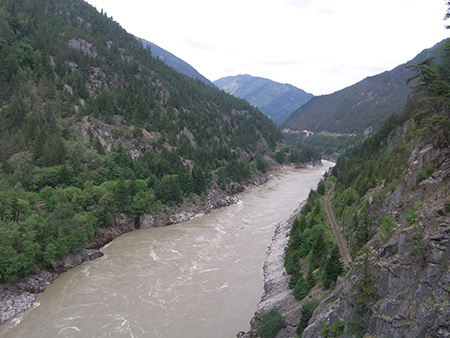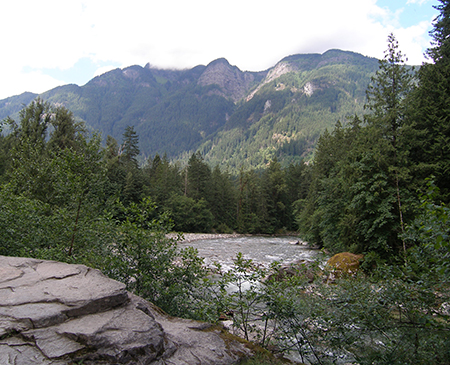Scary Mountain Check — A Time to Listen to Your Gut!
By Mike Davenport, EAA 89102, Langley, British Columbia
December 2019 - As a relatively new pilot with 60 hours' total time, I was busy making plans for longer cross-country flights. However, before the flying school would rent me an airplane to leave the confines of the Fraser Valley in southern British Columbia, they required that I successfully complete a supervised cross-country flight that included a mountain check.
The mountain check included, among other things, how to make a 180-degree turn in a valley to avoid weather or terrain. This was a reasonable expectation on their part, as any trip east of Vancouver includes travel through some pretty significant mountain ranges, and before the day was over, both weather and terrain would be dramatically demonstrated. The weather was a particular concern, as it was mid-April and local forecasts for the mountain VFR routes are wishful thinking at best at that time of year.
The day of the flight dawned clear in the valley and was forecast to be variable visibility in snow showers between Vancouver and Kamloops, clear to Kelowna and for the return to Vancouver. The airplane, a Piper Warrior, was gassed up and ready to go. The plan was to have the trip divided between three students to cut costs, with each student flying a leg and with Bob (the instructor) along to supervise. As things turned out, one student cancelled and so the flight was shortened by one leg, leaving out the leg to Kelowna and rerouting south from Kamloops through to Princeton.
We drew straws to see who would start the flight, and I drew the first leg. As the ceiling was around 4,000 feet, the trip to Kamloops would be in the canyon rather than above it. Once in the canyon, Bob had me do several 180-degree turns to escape simulated weather ahead, fly much closer to the canyon wall than I was comfortable with, and deal with the ever-increasing turbulence. Snow showers predominated but weren’t a concern, as the canyon is relatively wide and it was possible to go around the snow.
A brief stop followed in Kamloops saw us change seats. My flying was done for the day, but to get the most out of this part of the trip, I followed along with my maps to practise real-time navigation. Remember, this was before LORAN and GPS times. As I had the back seat to myself, I left my seat belt very loose so that I could slide to either side and confirm position. As we got closer to Princeton, the turbulence increased and the ride got rougher, but we persevered. After one particularly hard bump caused me to hit my head on the overhead ventilator, I decided that I had enough of that foolishness and snugged my belt, determined that if I couldn’t see it out of the left side of the aircraft, I wasn't interested.

Typical BC mountain flying terrain.
We made our turn point over the Princeton airport and headed for Hope and home following the Hope-Princeton Highway. As we travelled farther west, climbing between 6,000-foot mountains and over a 4,300-foot pass, the ceiling began to lower, and it got progressively darker up ahead in Manning Park. It then began to snow in earnest, and we were forced lower and lower over the highway. The next waypoint on this flight was the Hope Slide. The chart for this area advises that it is subject to rapid weather changes, and that was definitely happening.
On January 9, 1965, just west of Manning Park, half of a 6,500-foot mountain fell into the valley below, covering 2 miles of highway up to 500 feet deep with rock and mud, burying several vehicles and killing four people. Two of those bodies have never been recovered. This slide left a huge scar on the mountainside, which today is a clear marker for light planes following the VFR route through the Cascade mountain range. However, at least two weather-related aircraft crashes have occurred on the slide, accounting for eight fatalities. Both occurred in the month of April, as it happens.
Passing over the slide at about 250 feet AGL in about 1-mile visibility, and unable to actually see the slide, I spotted a Cessna 150 parked under trees just off a section of new but yet unpaved four-lane highway. With my voice likely one or two octaves above normal, I advised Bob of that fact.
By now we were headed down the valley toward the town-site of Hope and found ourselves looking up through the snow at the headlights of the cars above us on the highway. I reminded Bob that the C-150 looked pretty good back there behind us in the trees, but he didn't take the hint and headed down the hill.

Beautiful but challenging valley flying.
Now I must back up for a moment to explain that I felt I had more local knowledge than either the other student or our instructor as I drove this highway frequently in my day job. I knew where the corners were, and I was getting even more uncomfortable with nothing more constructive to do in the back seat except panic.
My gut was yelling at me that this was not going to end well, as I knew that the valley narrowed significantly and made a sharp left turn in the next couple of miles. I also felt that we were not going to make the turn and would end up on the canyon wall in a world of hurt.
I expressed that concern to Bob in no uncertain terms and was gratified to have him complete a classic 180 in textbook fashion. Flaps down, power up, and 45-plus degrees of bank and pull like mad. We headed back up the valley and completed an uneventful landing on a beautiful four-lane stretch of gravel about 10,000 feet long.
A Realtor from a local ski resort saw us land and drove out and picked us up. Back in his chalet, he treated us to hot chocolate and doughnuts as we settled in to wait for the weather to clear. I no sooner had my hot chocolate and the office phone rang. The Realtor handed it to me. I guess because I was the oldest, he must have thought I was in charge. It was the RCMP in Hope. It seems that several drivers had stopped into the police station to report an aircraft in trouble by the slide. I fessed up that indeed it was us, but we were fine and safe and, "Thanks for your interest but we will be leaving just as soon as the snow stops." They were good with that, and that was the end of any official involvement in our day.
As the afternoon wore on, boredom began to settle in and we returned to the airplane to wait the clearing. It would seem to clear momentarily but close in again by the time we got back in the plane. There did seem to be a pattern to it. It seemed to clear for a little longer each time, but after two times I suggested that we be sitting in the airplane and as soon as it starts to clear again, start up and go for it. Three times was the charm. We took off and in five minutes were out of the valley, over the town of Hope, and into clear, sunny weather.
Some significant lessons were learned that day. Pay close attention to the weather, especially in April in the mountains; always keep your options open; and never pass up the opportunity to land, as there may be hot chocolate.
